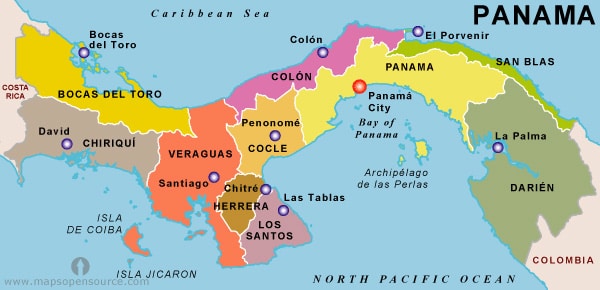Panama’s rising economy funding new investments in education and English training
Situated on the Central American isthmus, Panama boasts the two busiest ports in the world, a canal that sees 4% of all global trade pass through its waters, and one of the fastest-growing economies in the Americas.

The education system
Panamanian education consists of three stages: basic, secondary, and tertiary, with schooling free through the secondary level. Secondary students are 15 to 18 years of age, and the system at that level is divided between an academic track and a technical/vocational track. In 2013 about 34,000 students chose the former, and approximately 40,500 selected the latter. Public education, which serves 87% of enrolled students, is non-profit, while for-profit private schools serve the remaining 13%. The tertiary sector includes universities and institutes, with a public system made up of five major universities that together account for more than 92,000 students, and the private sector comprising 34 schools with another 47,000 students enrolled. Enrolment as a whole rose from 135,209 in 2009 to 138,894 in 2013, reflecting increasing demand within the country for skilled labour. Much of that enrolment increase was in private institutions, which raised their share percentage of all tertiary students in Panama from 20% in 2009 to more than a third today. There are indications, however, of significant capacity issues within the system. By some estimates, there are as many as 365,000 prospective students in Panama that are unable to pursue post-secondary studies due to lack of available spaces in universities and institutes. Panamanian education has improved over the long run, yet quality problems persist. According to the World Economic Forum’s Global Competitiveness Report 2014/15, the country ranks 83rd out of 144 for the quality of its education system, a position that represents a drop of eight places from the previous year’s ranking. The report also points out a lingering mismatch between educational offerings and labour market needs, which has in turn resulted in a persistent skills gap in Panama’s economy. In addition, divisions are wide between urban and rural areas with regard to the delivery of education services, adding to already-pressing problems of inequality. The indigenous and Afro-Caribbean populations that live primarily in outlying areas face discrimination, high levels of poverty, and low political representation, further reinforcing barriers to educational attainment for those populations. Despite problems in the overall system, several Panamanian universities have gained ground in the region, with seven making the QS University Rankings: Latin American 2015 (and four of those landing in the top 200 institutions ranked). Another positive metric is the percentage of women in higher education, which stands at 53% nationwide. The country’s human development index ranks as “high”, according to the UN’s Human Development Report 2015.
Recent initiatives
Half a decade ago, analysts warned that problems in Panamanian education were beginning to negatively affect the country. Infrastructure spending on a new subway and oceanfront highway in Panama City - not to mention a US$5.25 billion expansion of the Panama Canal - were driving the economy, but a lack of skilled labour meant that businesses had to bring in foreign workers. Anything resembling long-term sustainable growth would be impossible without changes to the education sector, and so, heeding those expert warnings, the Panamanian government stepped in. At the tertiary level, a 2010 strengthening of the accreditation process created the National Council for University Evaluation and Accreditation of Panama (CONEAUPA), which put together a new evaluation process for universities. Schools that met quality standards earned accreditation for six years, and all new academic programmes and majors were evaluated by the Comisión Técnica de Fiscalización, or Technical Supervision Commission. The 2010 changes also emphasised skills training, curriculum unification, divided the academic year into quarters, and established the Equipo Nacional de Innovación y Actualización Curricular (National Curricular Innovation and Renovation Team), which updates curricula throughout the year. The government increased financial support for students, more than quadrupling grants from the Institute for Training and Improvement of Human Resources (INADEH), from 2,863 university students in 2009 to 12,582 in 2013. This has helped push demand for university places and send students into a wider range of study areas. However, health sciences, administration of health science systems, and export and logistics programmes are three areas reported to be under-enrolled. Work on the education sector continued when President Juan Carlos Varela took office in July 2014. President Varela expanded infrastructure and reformed teacher training, while also increasing funding. The Ministry of Education’s budget increased from US$1 billion in 2013 to US$1.29 billion in 2015, with US$412 million of that slated for expanding infrastructure for middle and post-secondary schools. Looking forward, the government plans to establish a national assessment system that includes measuring learning outcomes, and participation in PISA (Programme for International Student Assessment) in 2018. In October 2015, Secretary of Competitiveness Miguel Ángel Esbri told a press gathering, "The Panamanian government’s [priority is] improving indicators with long term impact [such as] education and training of labour skilled to fill the jobs that the market demands."
Bilingualism and internationalisation
Panama ranks 48th out of 70 countries on the EF English Proficiency Index 2015 (and 11th out of 14 Latin American markets in the 2015 index). Though English has been mandatory in Panamanian schools since 2003, a lack of English proficiency continues to act as a drag on various employment sectors, particularly tourism - a US$5 billion-plus slice of the local economy. To improve English skills among both the student and teacher populations, the government launched the Progama Panamá Bilingüe, which will run from 2014 to 2019 with a US$50 million budget. As part of this programme, the government has been sending thousands of teachers - the projection is for an average of 2,000 teachers per year - to the United States, United Kingdom, and Canada for eight to 16 weeks of immersion training. It also recently added the English-speaking country of Barbados as a destination for trainees. Education Minister Marcela Paredes de Vásquez told The Business Year in July 2015 that she expects a fully bilingual education system to take 12 years to fully implement. The type of international cooperation exemplified by the Progama Panamá Bilingüe is an increasing important aspect of Panama’s work in improving its higher education system. The country has long-standing bilateral agreements with nations as far-flung as India, recently tightened or plans to tighten links with France, Jamaica, Morocco, and Trinidad and Tobago, and is relying in part on Singaporean technical aid to help construct a new Bilingual Higher Technical Institute. The government’s long-range plan is to become an international education hub in the Americas. With that goal in mind, Panama has also established the City of Knowledge, a new campus set up on a former US military base. Using tax breaks and a special migration regime for educational and research establishments, it has attracted 15 foreign academic institutions, as well as biotechnology, medical, and IT companies, and the United Nations’ Regional Hub for Latin America. The Panamanian government envisions taking advantage of the country’s good overall connectivity and Panama City’s growing international profile to attract students, academics, and researchers. In terms of outbound mobility, Panamanians who go abroad for study prefer the United States by a wide margin, reflecting more than a century of political ties. The next most popular countries in order, according to UNESCO, are Cuba, Spain, Saudi Arabia, Honduras, Italy, Chile, Canada, the UK, and France. On the whole, the country sends about 2,600 students abroad every year for tertiary studies, roughly half of which go to the US.
Future outlook
Panama’s education system is a work in progress, however economic and demographic growth will increase demand and in turn lead to an expansion in the sector, both in terms of institutions and curriculum. For international educators considering working in the country, signs point to a stable funding environment and increased investment in all areas and levels of schooling. Most of the government’s revenue is generated by a bustling tourism sector, the Panama Canal, and the Colón Free Trade Zone. But while Panama has cash coming in, it is also spending at a tremendous rate. Its debt tops US$23 billion, a stratospheric total for such a small country and more than US$5,700 for every person. The government is counting on a doubling of revenue from the Canal expansion to solve this problem. Other fiscal issues, however, could cut into any Canal windfall, including the revelation that 25 major US and European banks severed ties with banks in Panama due to concerns over money laundering. This last point ties into general corruption worries, as well environmental issues. Former President Ricardo Martinelli suspended most environmental regulations to help fuel a building boom, an expansion that has seen thousands of hectares of tropical wilderness plowed under. Now living in the US, Martinelli is accused of profiting personally from the construction boom to the tune of more than US$100 million and is under indictment in absentia for using public funds illegally. President Varela, the former vice president, ran a campaign that highlighted anti-corruption and transparency. But his continued commitment to education spending also indicates that a political consensus remains in place that a better-educated populace is a key to the country’s future prosperity.
Most Recent
-
The surging demand for skills training in a rapidly changing global economy Read More
-
US issues corrected student visa data showing growth for 2024 while current trends point to an enrolment decline for 2025/26 Read More
-
Survey finds US institutions expanding agency engagement and focusing on new student markets Read More


















